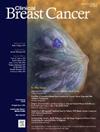让多学科团队参与制定务实的临床实践指南,以支持对高风险乳腺病变患者的管理。
IF 2.9
3区 医学
Q2 ONCOLOGY
引用次数: 0
摘要
导言:我们试图在多学科乳腺中心内制定临床指南,以支持管理高风险乳腺病变的决策。我们的目标是描述制定这些指南的过程,并评估其可接受性:方法:我们招募了临床利益相关者,以确定关键的 "高风险 "主题。利益相关者小组(外科、放射科、病理科)分别召开会议,利用现有文献综述和最佳可用证据对这些主题进行审查。指南最初于 2015 年制定,并于 2019 年更新。2023 年,我们就指南的可接受性对乳腺临床团队成员进行了调查,并对数据进行了总结:我们制定了临床指南,以处理非典型导管增生、扁平上皮不典型增生、非典型小叶增生/小叶原位癌、放射瘢痕/复杂硬化病变和乳头状瘤。指南的主要内容包括放射学与病理学相关性流程、活检后的患者处置(需要手术转诊、建议进行后续影像学检查)、手术切除的作用建议,以及不进行切除时的影像学随访建议。来自不同学科的 40 名临床团队成员(回复率为 66% [40/60])完成了可接受性调查。大多数人(78%)了解指南。受访者认为活组织切片检查后的处置建议、手术管理和随访成像是最有帮助的部分。大多数受访者(> 80%)认为这些内容非常有用/非常有用:我们利用主要利益相关者的意见制定了临床指南,以支持对高危乳腺病变患者的多学科管理。我们的指南已在我们的学术和社区实践中成功实施。未来将评估实施对临床结果的影响。本文章由计算机程序翻译,如有差异,请以英文原文为准。
Engaging Multidisciplinary Teams to Develop Pragmatic Clinical Practice Guidelines to Support Management of Patients With High-Risk Breast Lesions
Introduction
We sought to develop clinical guidelines within our multidisciplinary Breast Center to support decision-making for managing high-risk breast lesions. The objective is to describe the process used to develop these guidelines and assess perceived acceptability.
Methods
We recruited clinical stakeholders to identify key “high-risk” topics. Stakeholder groups (surgery, radiology, pathology) met separately to review the topics, leveraging existing literature reviews and best available evidence. Guidelines were initially developed in 2015 and updated in 2019. We surveyed breast clinical team members in 2023 regarding the perceived acceptability of the guidelines and summarized the data.
Results
We created clinical guidelines to address the management of atypical ductal hyperplasia, flat epithelial atypia, atypical lobular hyperplasia/lobular carcinoma in situ, radial scar/complex sclerosing lesion, and papillomas. Key guideline components included process for radiologic-pathologic correlation, patient disposition after biopsy (surgical referral needed, follow-up imaging recommended), recommendation for the role of surgical excision, and recommendation regarding imaging follow-up if excision not performed. Forty clinical team members (66% [40/60] response rate) completed the acceptability survey from varied disciplines. Most (78%) were aware of the guidelines. Respondents rated the recommendations for disposition after biopsy, surgical management, and follow-up imaging as the most helpful components. Most (> 80%) rated them to be very/extremely useful.
Conclusion
We leveraged input from key stakeholders to develop clinical guidelines to support the multidisciplinary management of patients with high-risk breast lesions. Our guidelines have been successfully implemented across our academic and community practice. Future steps will assess the impact of implementation on clinical outcomes.
求助全文
通过发布文献求助,成功后即可免费获取论文全文。
去求助
来源期刊

Clinical breast cancer
医学-肿瘤学
CiteScore
5.40
自引率
3.20%
发文量
174
审稿时长
48 days
期刊介绍:
Clinical Breast Cancer is a peer-reviewed bimonthly journal that publishes original articles describing various aspects of clinical and translational research of breast cancer. Clinical Breast Cancer is devoted to articles on detection, diagnosis, prevention, and treatment of breast cancer. The main emphasis is on recent scientific developments in all areas related to breast cancer. Specific areas of interest include clinical research reports from various therapeutic modalities, cancer genetics, drug sensitivity and resistance, novel imaging, tumor genomics, biomarkers, and chemoprevention strategies.
 求助内容:
求助内容: 应助结果提醒方式:
应助结果提醒方式:


